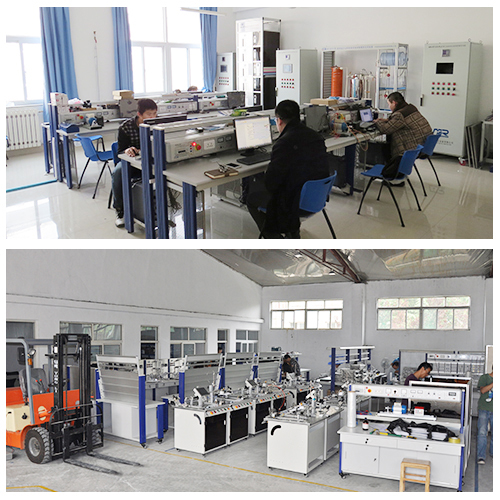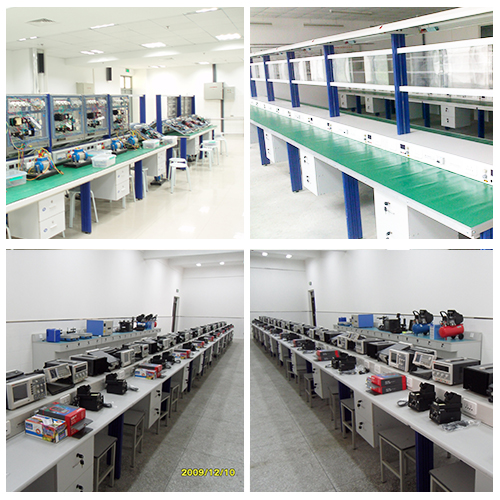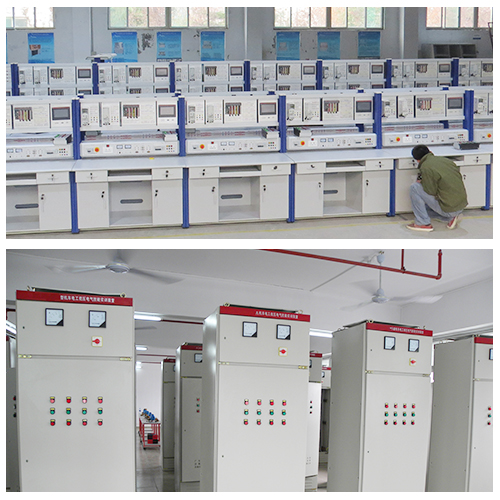MR501E Microcomputer Principle Experiment Box Electrical Training Equipment School Educational Equipment
System Overview
Introduction
Before using the microcomputer principle test box experimental system, please be sure to read this manual carefully so that you have a comprehensive understanding of the system. The system overview and installation and use are subject to this book, and the rest refer to the relevant chapters of the corresponding volume.
System Features
1. The microcomputer principle test box has an external 51 emulator, a compact system structure, full resource sharing, no bus switch switching, and automatic identification of CPU type.
2. The experimental system has perfect software and hardware configuration, the simulation software supports Win98/2000/XP and other operating systems, and supports the development of assembly language and C language. The experimental content is rich, and it is an ideal platform for teaching single-chip microcomputers, microcomputer principles and interfaces.
System resource allocation
1.System ROM/RAM storage space allocation
2.I/O port address allocation
System installation and use
51 experimental system installation and use
1. Installation of 51 part simulation software: DICE-Microcomputer Principle Test Box_KEIL CDROM\TOOL\Keil V809a \1Install\c51v809a.exe" installation file, according to the prompts of DICE-Microcomputer Principle Test Box_KEIL CDROM\TOOL\Keil V809a \KEIL V809a Installation Instructions.doc", complete the installation of 51 part KEIL simulation software. For detailed instructions, see DICE-Microcomputer Principle Test Box_KEIL CDROM\REF\DICE-KEIL USB Emulator User Manual.pdf.
2. System settings
Set all SW3~SW5 switches to ON, insert the 51K-CPU card into the CPU card holder (on both sides of the 8088Unit), and short the short-circuit block of the 51K-CPU card to the "off-chip program" (when running offline or using an emulator for experiment, the short-circuit block is connected to the "off-chip program" position. When the program is downloaded to the internal FLASH of the single-chip computer AT89S52 through a programmer or ISP online, the short-circuit block is connected to the "on-chip program.")
3. ISP online programming

When using a download cable to download the HEX file to the internal FLASH of the single-chip computer, set the other short-circuit block on the 51K-CPU card to "programming mode". For normal experiments, set it to "general mode" when executing the program.
For the specific use and settings of ISP online programming, see the CD DICE-Microcomputer Principle Test Box_KEIL CDROM\REF\51 Single-chip Computer ISP Download Function Application (USB Interface).doc.
4. Offline use
When the power of the experimental instrument is turned on, the digital tube should display "P.___ ___51", indicating that the experimental system is in the 51 offline state. You can enter the corresponding experimental number through the experimental instrument key, and then press the [EX/FV] key to execute the experimental program at full speed. For example, enter the number keys 0 and 9, connect the wires of the A/D experiment, and then press the [EX/FV] key to run the A/D experiment of experimental sequence number nine.
5. Connecting to PC operation
After confirming that the power is off, remove the AT89S52 microcontroller chip on the 51K-CPU card, plug the IDC40 plug on the 40-core white flat cable into the IDC40 socket of the DICE-KEIL USB emulator, and then use the randomly distributed USB cable to connect the emulator to the PC; plug the 40-core emulation head at the other end of the 40-core white flat cable into the green locking socket in the upper right corner of the DICE-5210K experimental instrument.
Note: Do not insert it in reverse. The first pin on the upper left corner of the 40-pin DIP socket is the first pin of the microcontroller. There is an arrow on the first pin of the 40-pin emulation header. The DICE-KEIL USB emulator should be placed on the right side of the experimental circuit board. If you have any questions, please call our technical support.
(5) For details on the installation and use of software and drivers, please refer to the emulator manual.
Note:

(1) Whether it is the plugging and unplugging of integrated circuits and CPU cards, the connection of communication cables, the setting of jumpers, or the connection of experimental circuits, make sure to do it under power off conditions, otherwise it may cause damage to the equipment.
(2) After the experimental circuit is connected, it should be carefully checked before turning on the power.
Experimental connection
51 microcontroller experimental wiring table
Experiment 1: P1 port light up experiment P1.0~P1.7→L1~L8(led)
Experiment 2: P1 turn signal experiment P1.0→K1,P1.1→K2
P1.4→L1,P1.5→L2,P1.6→L5,P1.7→L6
Experiment 3: P3.3 port input, P1 port output P3.3→K1
P1.0~P1.7→L1~L8(led)
Experiment 4 Industrial Sequential Control P3.4 →K1,P3.3→K2
P1.0~P1.6→L1~L7,P1.7→VIN,
JP short circuit block connected to ON (audio amplifier)
Experiment 5 8255 A, B, C port output square wave Without any connection, observe the square wave output from PA, PB and PC ports
Experiment 6 8255 PA port controls PB port PA0~PA7→K1~K8,Q0~Q7→L1~L8
Experiment 7 8255 Control Traffic Light 8255 PA0~PA7 Connect the light emitting diodes in sequence L7~L5、L3~L1
Experiment 8 Simple I/O Expansion Y0~Y7 connects to K1~K8, Q0~Q7 connects to L1~L8, CS1 connects to FF80H, CS2 connects to FF90H hole, JX0 connects to JX7 (D0~D7)
Experiment 9 A/D conversion experiment IN0→VOUT,VIN→+5V,CS4→FF80H,JX0→JX6
WR→IOWR,RD→IORD,ADDA、ADDB、ADDC→0V(Grounding)
Experiment 10 D/A conversion experiment CS5→FF80H,JX2→JX0,WR→IOWR,AOUT→Voltmeter
Experiment 11 8279 keyboard display experiment CS6→FF80H,JRL→JR,JSL→JS,JOUT→JLED
SW3, SW4, SW5 are set to OFF (set to ON after the experiment)
Experiments 12 and 13 (Printer) Special cable connects CZ4 (PRT) to micro printer interface (optional)
*Experiment 14 Calendar clock DS12887 control experiment CZ7 (mainboard) → CZ1 (MC3), P3.2 → /IRQ (MC3) (optional)
Experiment 15 I2C memory card reading and writing experiment P3.0→SCL,P3.1→SDA,INS→P1.0,P1.0~P1.2→L1~L3(Light Emitting Tube)
Experiment 16 ISD1730 Recording See the experimental instructions below.
Experiment 17 ISD1730 playback
Same asExperiment 16

Experiment 18 Relay Control P1.0→JIN,JZ→Grounding,JK→L1,JB→L2
Experiment 19: Stepper Motor Control P1.0~P1.3→HA~HD
Experiment 20 8253 Square Wave CLK0→2 MHZ,GATE0→5V,CS3→FF80H,Connect OUT0 to an oscilloscope, run the program, and observe whether the oscilloscope has a square wave output.
Experiment 21: Closed-loop speed regulation experiment of small DC motor P1.0~P1.7----->K8~K1;(The DC motor speed can be set through K1~K8, the number of turns/S, hexadecimal input)
P3.2----->HOUT(DC Motor Sensor Output);
CS5----->FF80H,
AOUT----->DJ
WR----->/IOWR,
JX2----->JX0。
Run the program: the digital tube displays "set speed value - - current speed value"! Note: Do not set the turns/S value too high, because the actual speed of a small DC motor is about 1F/S.
Experiment 22 LED 16*16 dot matrix display experiment JLPC→JX16,JHP1→JX10,JLPA→JX9,JLPB→JX15
Experiment 23 128*64 LCD display experiment JX10→JX12,JX11→JX14,/RST→/RST
Experiment 24 8250 programmable asynchronous communication interface experiment (self-transmission and self-reception) JX0→JX3,CS7→FF80H,TXD→RXD
Experiment 25
8251 programmable communication interface experiment (with PC) (1) 8251 unit: CS8→FF80H, CLK→1.8432M, T/RXC→OUT1, TXD→EX-TXD, RXD→EX-RXD, JX20→JX17; (Note: TXD and RXD are in the 8251 unit; EX-TXD and EX-RXD are in the CZ11 user communication port, and the corresponding numbers are TXD and RXD)
(2) 8253 unit: CS3→FF90H, GATE1→+5V, CLK1→1.8432M;
(3) Switch settings: Set SW3, SW4, and SW5 to ON, and connect the PC serial port to the CZ11 user communication port socket (offline operation, no emulator is required, and the PC must have two serial ports for online operation);
(4) Run the "Serial Port Debug Assistant", set the corresponding serial port and baud rate (9600), type 25 in P mode and press the F0/EX execution key, the display will flash P, press the numeric keys on the small keyboard, and the corresponding numbers will be displayed on the PC screen, and press MON to return to P mode.
Experiment 26 MCU RS232 / RS485 serial transmission experiment (dual machine communication) (1) Prepare two microcomputer principle test boxes and determine that machine 1 is for sending and machine 2 is for receiving;
(2) When used as an RS232 interface experiment: P3.0 and P3.1 of machine 1 and machine 2 are cross-connected, and the two machines share the same ground.
(3) When used as an RS485 interface experiment, P3.0→R0, P3.1→DI, K1→TEN/R (switch K1, when the switch is at a high level, it is "sending"; when the switch is at a low level, it is "receiving").
A and B pairs of machine 1 and machine 2 should be connected with wires, and the two machines share the same ground.
(4) Run machine 2 first, so that machine 2 is in the standby receiving state P. Then run machine 1, so that machine 1 is in the sending state P. Press the number key on the keyboard of machine 1, and the corresponding number key value should be displayed on the digital tube of machine 2.
Experiment 27 MCU RS232 / RS485 serial reception experiment (dual machine communication) Experimental connection is the same as Experiment 26
Experiment 28 Intelligent temperature measurement experiment based on DS18B20 P1.0→DQ
Experiment 29
Infrared communication experiment in single chip microcomputer system P3.2→HOUT,P1.5→SP(buzzer)
Experiment 30 TL549 serial A/D conversion experiment (AIN) analog input channel is connected to the potentiometer VOUT hole with a wire, the potentiometer input terminal VIN is connected to +5V, I/O CLOCK (CLK) is connected to P1.6, DATA OUT (DO) is connected to P1.7, CS is connected to P1.0
Experiment 31 TLC5615 10-bit D/A serial conversiriment DIN→P1.2, SCLK→P1.1,/CS→P1.0,OUT→DJ
Experiment 32 PCF8563 real-time clock/calendar chip experiment SDA→P1.7, SCL→P1.6, K1→P1.0, when P1.0 is at a low level, the digital tube displays "hour, minute, second"; when P1.0 is at a high level, the digital tube displays "year, month, day".
Experiment 33 MAX813L watchdog reset circuit experiment For detailed experimental connections, please refer to the experimental instructions.
Experiment 34 LM331 voltage/frequency conversion experiment VIN0 is connected to the VOUT hole of the potentiometer, the input terminal VIN of the potentiometer is connected to +5V, and the frequency output terminal FOUT is connected to P3.5

Experiment 35: Serial memory chip 93C46 reading and writing experiment P3.0→CS,P3.1→SK,P3.2→DI,P3.3→DO
P1.0~P1.7→L1~L8(led)
Experiment 36 AT24C02 I2C bus memory read and write experiment SCL→P1.6, SDA→P1.7, P1.0→L1 (write indicator), P1.1→L2 (read indicator), A0, A1, A2 are grounded.
Experiment 37 PWM pulse width modulation experiment PWM_IN→P1.7,V_OUT→DJ(Small DC motor)
Experiment 38 74LS164 serial-to-parallel conversion P3.0→A/B,P3.1→CP,P1.0→CLR,Call in the program and run it, and the two-digit digital tube will display numbers 00~99 in a cycle.
Experiment 39
165 parallel-to-serial conversion experiment P1.0~P1.7→D7~D0,P3 .0→Q7,P3.1→CLK(CP),P3.2→S/L,
CKIN→GND。
Experiment 40
Electronic music performance experiment P1.5→SP (buzzer) or P1.5→VIN (speaker, audio amplifier unit)
Experiment 41
Temperature and pressure experiment CS4→FF80H, JX0→JX6, WR→/IOWR, RD→/IORD, ADDA, ADDB, ADDC→0V (ground)
Temperature test: IN0→VT Pressure test: IN0→VP



